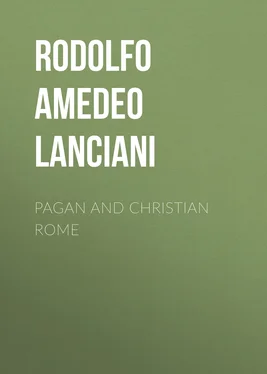Rodolfo Amedeo Lanciani - Pagan and Christian Rome
Здесь есть возможность читать онлайн «Rodolfo Amedeo Lanciani - Pagan and Christian Rome» — ознакомительный отрывок электронной книги совершенно бесплатно, а после прочтения отрывка купить полную версию. В некоторых случаях можно слушать аудио, скачать через торрент в формате fb2 и присутствует краткое содержание. Жанр: foreign_edu, История, История, на английском языке. Описание произведения, (предисловие) а так же отзывы посетителей доступны на портале библиотеки ЛибКат.
- Название:Pagan and Christian Rome
- Автор:
- Жанр:
- Год:неизвестен
- ISBN:нет данных
- Рейтинг книги:3 / 5. Голосов: 1
-
Избранное:Добавить в избранное
- Отзывы:
-
Ваша оценка:
- 60
- 1
- 2
- 3
- 4
- 5
Pagan and Christian Rome: краткое содержание, описание и аннотация
Предлагаем к чтению аннотацию, описание, краткое содержание или предисловие (зависит от того, что написал сам автор книги «Pagan and Christian Rome»). Если вы не нашли необходимую информацию о книге — напишите в комментариях, мы постараемся отыскать её.
Pagan and Christian Rome — читать онлайн ознакомительный отрывок
Ниже представлен текст книги, разбитый по страницам. Система сохранения места последней прочитанной страницы, позволяет с удобством читать онлайн бесплатно книгу «Pagan and Christian Rome», без необходимости каждый раз заново искать на чём Вы остановились. Поставьте закладку, и сможете в любой момент перейти на страницу, на которой закончили чтение.
Интервал:
Закладка:
(Fresco in S. Clemente, done at the order of Maria Macellaria)
But I am digressing from my subject. Another step of the religious and material transformation of the city is marked by the substitution of chapels and shrines for the old aræ compitales , at the crossings of the main thoroughfares. The institution of altars in honor of the Lares , or guardian genii of each ward or quarter, is ancient, and can be traced to prehistoric times. When Servius Tullius enclosed the city with his walls, there were twenty-four such altars, called sacraria Argeorum . Two facts speak in favor of their remote antiquity. The priestess of Jupiter was not allowed to sacrifice on them, unless in a savage attire, with hair unkempt and untrimmed. On the 17th of May, the Vestals used to throw into the Tiber, from the Sublician bridge, manikins of wickerwork, in commemoration of the human sacrifices once performed on the same altars.
When Augustus reorganized the capital and its wards, in the year 7 b. c., the number of street-shrines had grown to more than two hundred. Two hundred and sixty-five were registered, a. d. 73, in the census of Vespasian; three hundred and twenty-four at the time of Constantine. A man of much leisure, and evidently of no occupation, the cavaliere Alessandro Rufini, numbered and described the shrines and images which lined the streets of Rome in the year 1853. As modern civilization and indifference will soon obliterate this historical feature of the city, I quote some results of Rufini's investigations. 24There were 1,421 images of the Madonna, 1,318 images of saints, ornamented with 1,928 precious objects, and 110 ex-votos; 1,067 lamps were kept burning day and night before them,—a most useful institution in a city whose streets have not been regularly lighted until recent years.
The Shrine and Altar of Mercurius Sobrius.
As prototypes of a classical and Christian street-shrine, respectively, we may take the ædicula compitalis of Mercurius Sobrius, discovered in April, 1888, near S. Martino ai Monti, and the immagine di Ponte , at the corner of the Via dei Coronari and the Vicolo del Micio. The shrine of Mercury near S. Martino was dedicated by Augustus, in the year 10 b. c. The inscription engraved on the front of the altar says: "The emperor Augustus dedicated this shrine to Mercury in the year of the City, 744, from money received as a new-year's gift, during his absence from Rome."
Suetonius (Chapter 57) says that every year, on January 1, all classes of citizens climbed the Capitol and offered strenæ calendariæ to Augustus, when he was absent; and that the emperor, with his usual generosity, appropriated the money to the purchase of pretiosissima deorum simulacra , "the most valuable statues of gods," to be set up at the crossings of thoroughfares. Four pedestals of these statues have already been found: one near the Arch of Titus, at the beginning of the sixteenth century; one, in 1548, near the Senate House; one, in the same year, by the Arch of Septimius Severus. The fourth pedestal, that recently discovered near S. Martino ai Monti, was raised at the crossing of two important streets, the clivus suburanus (Via di S. Lucia in Selci), and the vicus sobrius (Via dei Quattro Cantoni), from which the statue was nicknamed Mercurius Sobrius , "Mercury the teetotaller."
The immagine di Ponte , in the Via dei Coronari, the prototype of modern shrines, contains an image of the Virgin in a graceful niche built, or re-built, in 1523, by Alberto Serra of Monferrato, from designs by Antonio da Sangallo. Its name is derived from that of the lane leading to the Ponte S. Angelo (Canale di Ponte). The house to which it belongs is No. 113 Via dei Coronari, and No. 5 Vicolo del Micio.
Monumental crosses were sometimes erected instead of shrines. Count Giovanni Gozzadini has called the attention of archæologists to this subject in a memoir "Sulle croci monumentali che erano nelle vie di Bologna del secolo XIII." He proves from the texts of historians, Fathers, and councils that the practice of erecting crosses at the junction of the main streets is very ancient, and belongs to the first century of the freedom of the Church, when the faithful withdrew the emblem of Christ from the catacombs, and raised it in opposition to the street shrines of the gentiles. Bologna has the privilege of possessing the oldest of these crosses. One bears the legend "In the name of God; this cross, erected long since by Barbatus, was renewed under the bishopric of Vitalis (789-814)." This class of monuments abounds in Rome, although it belongs to a comparatively recent age. Such are the crosses before the churches of SS. Sebastiano, Cesareo, Nereo ed Achilleo, Pancrazio, Lorenzo, Francesco a Ripa, and others.
The most curious and interesting is perhaps the column of Henry IV. of France, which was erected under Clement VIII. in front of S. Antonio all' Esquilino, and which the modern generation has concealed in a recess on the east side of S. Maria Maggiore. It is in the form of a culverin—a long slender cannon of the period—standing upright. From the muzzle rises a marble cross supporting the figure of Christ on one side, and that of the Virgin on the other. It was erected by Charles d'Anisson, prior of the French Antonians, to commemorate the absolution given by Clement VIII. to Henry IV. of France and Navarre, on September 17 of the year 1595. The monument has a remarkable history. Although apparently erected by private enterprise, the kings of France regarded it as an insult of the Curia, an official boast of their submission to the Pope; and they lost no opportunity of showing their dissatisfaction in consequence. Louis XIV. found an occasion for revenge. The gendarmes who had escorted his ambassador, the duc de Crequi, to Rome, had a street brawl with the Pope's Corsican body-guards; and although it was doubtful which side was to blame, Louis obliged Pope Alexander VII. to raise a pyramid on the spot where the affray had taken place, with the following humiliating inscription:—
"In denunciation of the murderous attack committed by the Corsican soldiers against his Excellency the duc de Crequi, Pope Alexander VII. declares their nation deprived forever of the privilege of serving under the flag of the Church. This monument was erected May 21, 1664, according to the agreement made at Pisa."
The revenge could not have been more complete; so bitter was it that Alexander VII. drew a violent protest against it, to be read and published only after his death. His successor, Clement IX., a favorite with Louis XIV., obtained leave that the pyramid should be demolished, which was done in June, 1668, with the consent of the French ambassador, the duc de Chaulnes. Whether by stipulation or by the good will of the Pope, the inscription of the column of Henry IV. was made to disappear at the same time. We have found it concealed in a remote corner of the convent of S. Antonio. 25The column itself, and the canopy which sheltered it, fell to the ground on Thursday, February 15, 1744; and when Benedict XIV. restored the monument in the following year, he severed forever its connection with these remarkable historical events, by dedicating it DEIPARÆ VIRGINI. Having been dismantled in 1875, during the construction of the Esquiline quarter, it was reërected in 1880, not far from its original place, on the east side of S. Maria Maggiore,—not without opposition, because there are always men who think they can obliterate history by suppressing monuments which bear testimony to it.
One of the characteristics of ancient sanctuaries, by which the weary pilgrim was provided with bathing accommodations, is also to be found in the old churches of Rome. We are told in the "Liber Pontificalis" that Pope Symmachus (498-514), while building the basilica of S. Pancrazio, on the Via Aurelia, fecit in eadem balneum , "provided it with a bath." Another was erected by the same Pope near the apse of S. Paolo fuori le Mura, the supply of water of which was originally derived from a spring; later from wheels, or noriahs, established on the banks of the Tiber. Notices were written on the walls of these bathing apartments, warning laymen and priests to observe the strictest rules of modesty. One of these inscriptions, from the baths annexed to the churches of SS. Sylvester and Martin, is preserved in section II. of the Christian epigraphic museum of the Lateran. It ends with the distich:—
Читать дальшеИнтервал:
Закладка:
Похожие книги на «Pagan and Christian Rome»
Представляем Вашему вниманию похожие книги на «Pagan and Christian Rome» списком для выбора. Мы отобрали схожую по названию и смыслу литературу в надежде предоставить читателям больше вариантов отыскать новые, интересные, ещё непрочитанные произведения.
Обсуждение, отзывы о книге «Pagan and Christian Rome» и просто собственные мнения читателей. Оставьте ваши комментарии, напишите, что Вы думаете о произведении, его смысле или главных героях. Укажите что конкретно понравилось, а что нет, и почему Вы так считаете.












